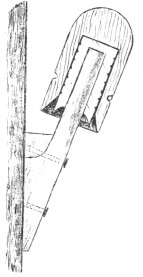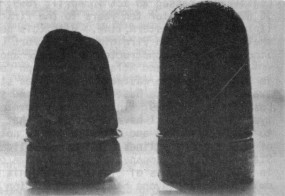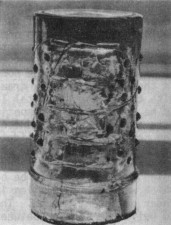"Threadless Corner" -- The First Transcontinental Telegraph Line
by Ray Klingensmith
Reprinted from "INSULATORS - Crown Jewels of the Wire", May 1979, page 8
In the 1840's
the telegraph industry had grown to unbelievable size in the eastern section of
this country. Most major American cities east of the Mississippi were linked
with the "magic wire".
In the late 1840's, with the discovery of gold
in California, there was a massive movement of people to the west coast. With
this drastic increased population, a need for organization was realized, and in
1849 the State of California entered the Union. In the early 1850's, after the
State and its residents had become somewhat settled and organized, a handful of
men set out to link the important cities with telegraph lines.
In May, 1852,
Oliver Allen and Clark Burnham were granted permission from the State to build a
line between San Francisco and Marysville. One requirement was that the line had
to be in operation by November 1, 1853. Thus the California Telegraph Company
was formed. The newly formed company met with many difficulties, and financially
the promoters became unable to complete the line. In June, 1853, a
reorganization of the old company brought forth a new organization known as the
California State Telegraph Company. James Gamble, who had worked under Judge
Caton and his famous Illinois and Mississippi Telegraph Company, was hired to
supervise the construction. Gamble, with a small band of men, set out to
complete the line, which was 200 miles in length. With his experience, he was
able to complete the line on October 25, 1853. This was within one week of the
time allowed by the State. At once the newly completed line met success
financially.
With the success of the California State Telegraph Company, it was
inevitable that other lines would also spring up. The Alta Telegraph Company was
formed, and in January 1854 its line linked Sacramento with Mormon Island,
Diamond Springs, Placerville, Coloma, Auburn, Grass Valley and Nevada City.
In
the late 1850's, with the telegraph industry developed well in California,
interest rose in linking that state with the eastern part of the country with a
telegraph line. Hiram Sibley, a well known telegraph personality who was
associated with Western Union, had visions of a transcontinental line for some
time, but other more important matters shadowed his dream, at least temporarily.
The idea of a line through vast plains, mountain ranges, and unsettled territory
seemed too risky a venture to most people at that time.
In May, 1858, the
Placerville, Humboldt & Salt Lake Telegraph Company was organized, with
Frederic and Albert Bee the main promoters. The line was to have been built from
Placerville to Salt Lake City. Federal Government aid was sought, without
success, due primarily to the conflict of racism between the North and South.
However, the State government was more cooperative. The California Legislature
passed an act in April, 1859, pledging a subsidy of $6,000 per year for ten
years to the first telegraph company to be linked with an eastern line. With
this news, the Bee brothers built their line through Virginia City to Fort
Churchill. However, that line was poorly constructed and became another lost
dream.
The Pacific and Atlantic Telegraph Company also had a design in building
a line eastward. Its lines started in San Francisco and traveled along the
Butterfield overland stage route. It reached Los Angeles in 1859. This line may
have used the CD 1000.5 "sleeve type" insulator. I have often heard
that type of insulator referred to as the "Pacific and Atlantic". I'm
not familiar with the extent of that company's lines. It was consolidated into
the California State Telegraph Company, along with some other telegraph
companies, in 1860. Its hopes of linking California with the East also soon
dwindled. (If anyone has any information on the "Pacific and Atlantic"
insulators, please inform me of their location of actual use.)
Finally, after
much debate in Congress, the Pacific Telegraph Act was made into law on June 16,
1860. This act, with many requirements to be carried out by line contractors,
allowed the building of a telegraph line to link San Francisco with a point on
the boundary of the State of Missouri. Bids to build the line were accepted,
with a maximum bid of $40,000 allowed. Hiram Sibley, with Western Union, made a
bid of $40,000, which was accepted. There were three lower bids, but each of
these was withdrawn by their bidders, and Sibley's bid became the one accepted.
With the bid accepted, Western Union quickly set out to get the work under way.
Jeptha Wade was sent to California to organize the competing lines there, and
Sibley sought aid from other telegraph companies in the east to help by drawing
up contracts for their lines to link with the transcontinental line. Wade was
successful in California, as he convinced the competing telegraph companies
there to consolidate and help Western Union build the western section of the
line. The newly formed consolidation became known as the California State
Telegraph Company. (For a detailed story on Jeptha Wade, see August and
October 1978 issues of Crown Jewels magazine.) Western Union decided it would be
best if the construction of the line, which was over 2000 miles in length, were
completed in sections under different groups. The Overland Telegraph Company was
formed to build the section between Carson City and Salt Lake. The Pacific
Telegraph Company was to build the section between Salt Lake and Omaha. The
Missouri and Western Telegraph Company line between St. Louis and Omaha would
form the final link between the East and the West.
During the summer of 1860
Edward Creighton surveyed the possible routes of the line. Under his
superintendence, it was decided to build the line from Omaha, Nebraska, along
the Platte River, from Fort Kearney to Fort Laramie, then along the Sweetwater
River, through South Pass, and eventually to Salt Lake. At the same time, the
Overland Telegraph Company, under the superintendence of James Gamble, was to
build the section of line eastward from the California State line, at Carson
City, through Ruby Valley, Egan Canyon and Deep Creek and on to Salt Lake, where
it was to join with Creighton's line. Materials to be used on the line included
high quality galvanized iron wire, a minimum of 25 poles per mile, and the best
insulation possible. The "Wade" type insulator was specified on the
eastern section, which is understandable, with Wade's influence on the project.

"Wade Type" Insulator.

Paul Plunkett Photo
Wood covered Wades. On left, "used" condition.
On right, "new" condition.
With all the specifications drawn up, actual construction got under way in the
spring of 1861. On May 27, 1861, James Gamble left Sacramento with his supply
train of 25 wagons of telegraph materials, 50 men, 228 oxen, and 18 mules and
horses. They set out to cross the Sierra Nevadas and reach Carson City in just a
little over two weeks. However, difficulties arose, and it was late June before
they reached their destination and work could begin. While that group was headed
eastward to start its work, another group was to start at Salt Lake and build
the line westward until it met Gamble, to complete the western section.

Paul Plunkett Photo
"Dot-Dash" Wade.
At the same time another party
was to have begun at Salt Lake to build the line eastward until it met Edward
Creighton, who had started in Omaha and was constructing the line westward.
Creighton's task of completing the eastern section became even more demanding
when, on June 15, the telegraph line which was to link Omaha with the east was
torn down in a Civil War campaign. The line between Omaha and St. Louis could no
longer be depended on for an eastern link, so it was decided that a new section
would have to be built between Omaha and Chicago. This would be farther north,
where there would be less chance of destruction by Confederate raiders.
It was hoped to complete the line by the winter of 1861. The first pole set on
the eastern section out of Omaha was on July 4th. From that day on the men
worked from daylight until dark to complete the line. The problems which arose
were many. Some areas were without the proper timber needed for supplying poles,
and in some cases poles had to be hauled in from several hundred miles. Water
had to be transported with the construction gang to meet their needs. It's
reported that wire and insulators for the western section had to be shipped from
New York via Cape Horn to San Francisco, and then taken over the Sierra Nevadas
to be used; or sent from the east, up the Missouri River and across the plains
for hundreds of miles to Salt Lake. Another problem feared by the promoters of
the line was the trouble that might be caused by the Indians in the western
section. However, good relations were shared by the construction crew and the
Indians. Gamble reported that the Indians gained respect for the telegraph after
an incident that happened one day as a thunderstorm was approaching. The
telegraph men, wearing gloves, were not affected by current traveling through
the wires as lightning struck in the distance. However, a helpful Indian,
standing on the ground, grasped the wire with his bare hands and received a
shock that sent him scurrying away!
The Pony Express, which linked St. Joseph, Missouri, and Sacramento, California, also played a role in the building of the
telegraph line. Before the start of the telegraph construction, the Pony Express
carried messages the entire distance from Missouri to California. After
construction began, the Pony Express route became shorter each day, as messages
were sent by telegraph as far as the line was completed, and from there the
messages went by "Express". As the lines moved closer to each other,
the trip on horseback became shorter. This was beneficial to both concerns. The
Pony Express could deliver its messages quicker, and the telegraph men knew the
location and progress of the other telegraph section workers.
All went on
without any great trouble, and a friendly race became evident, to see which
section would be completed first. The race seemed very close for some time.
However, the western section crew became aware of the fact that poles would not
be supplied on time for the last remaining 50-60 miles between Ruby Valley and
Schell Creek. There were mountains in the area with sufficient trees, but it was
October, and the workers sent for the job of cutting them for poles feared they
would be caught in a storm on the way back down. Gamble, learning of this, went
to the area himself and convinced the workers to transport the needed poles down
the mountain. His traveling with them gave them the needed assurance, and twenty
wagon loads of poles were taken down the mountain to the line site, where
construction got under way once again. On October 18, 1861, Creighton's section
was completed; and six days later, on October 24, Gamble's western section was
complete, linking the east and west with a telegraph line. That evening Stephen
J. Field transmitted the following message to Abraham Lincoln:
|
"To
Abraham Lincoln, President of the United States:
In the temporary absence of the
Governor of the State I am requested to send you the first message which will be
transmitted over the wires of the telegraph line which con nects the Pacific
with the Atlantic States. The people of California desire to congratulate you
upon the completion of the great work. They believe that it will be the means of
strengthening the attachments which bind both the East and the West to the
Union, and they desire in this -- the first message across the continent -- to
express their loyalty to the Union and their determination to stand by its
Government on this its day of trial. They regard that Government with affection
and will adhere to it under all fortunes.
Stephen J. Field
Chief Justice of
California" |
Another great work of the age had been completed. The benefits
from the new line were soon realized by nearly all Americans. News could be sent
from coast to coast in an instant. Western Union became aware at once of the
financial benefits which could be expected. In fact, the line was much more of a
success than most people thought it would be.
As stated earlier, the section of
line between Omaha and St. Louis was in a region of Civil War conflict. The new
northern route between Omaha and Chicago was completed in January, 1862, by the
Illinois & Mississippi Telegraph Company. This northern route assured the
people it would not be in danger from southern sympathizers.
The type of
insulators used on the eastern section was the Wade, as mentioned earlier. Those
used on the western section may also have been Wades, but I'm not sure. I recall
a lady finding a dot-dash Wade in the vicinity of the western line. If anyone
knows what types were used, please notify me of it. Also, if any other types are
known to have been used on the eastern section, let me know. James Gamble made
mention of insulators and wire being shipped from New York City for the western
section. The insulators may or may not have been from a New York City supply
house. They could have been made elsewhere and shipped from there. Chester was
in business in New York at the time. I've heard of CD 735 Chesters being found
in California, but what about Nevada and Utah? I'd really appreciate it if
anyone with some knowledge on the subject would contact me and let me know.
Thanks to the Paul Plunkett family for the Wade photos. I'd also like to make
mention that all the nice photos used in the Wade article in the October issue
were theirs. Somehow, full credit to them failed to be mentioned.
To all
collectors, let me hear from you.
|
